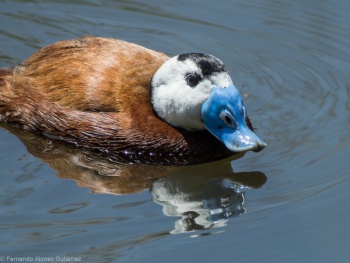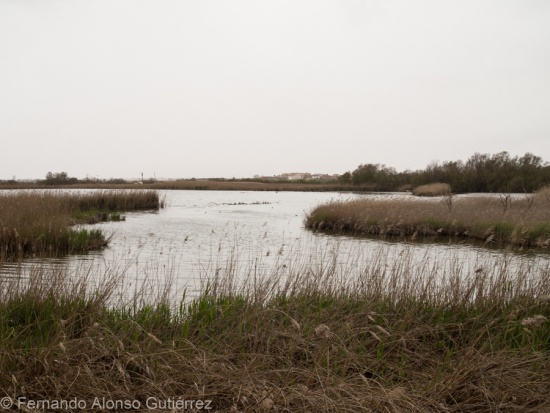Overview
Included in La Mancha wetlands, a large cluster of shallow wetlands associated to the Western Mancha aquifer located in the corner formed by the provinces of Ciudad Real, Cuenca and Toledo, about 150 km SW from Madrid.
In contrast to most of the above wetlands, Charcones de Miguel Esteban has an artificial origin; 1950s aerial photographs show that the original (destroyed) wetland near the village was in a different place. Charcones means "big ponds" in Spanish. It was the construction of a series of basins to treat the sewage from the town of Miguel Esteban (a pair of small primary treatment basins and a couple of big aerobic ponds to complete the treatment) that made birdlife flourish in them. These are relatively deep, very eutrophic and with a developed reed fringe, favouring specially diving wildfowl. The leaks in these main ponds, together with the existence of a natural depression has created a more "natural" shallow inundation area across the track that surround them, which holds water only after good rains. Since 2016 water levels are managed in this shallow area, favouring concentrations of flamingoes, waders and wildfowl.
Birds
Notable Species

Close-up of a male White-headed Duck at Charcones de Miguel Esteban, May 2015
Perhaps the best asset of Charcones de Miguel Esteban is the possibility of observing White-headed Duck at very close range when they patrol the ditch very near the hides around the main pond. But it also holds other interesting species, such as Ferruginous Duck (scarce), Red-crested Pochard, Black-necked Grebe or Greater Flamingo. Greylag Goose has bred in the area the last years.
During winter good numbers of wildfowl Northern Shoveler, Gadwall, Mallard, Common Teal, Common Shelduck, Common Pochard and Eurasian Coot. In summer Whiskered Tern, Black Tern and Gull-billed Tern can be seen. Several Marsh Harrier breed at the site.
Waders favour the inundation area south of the main ponds, including Pied Avocet, Ruff, Black-tailed Godwit, Dunlin, Little Stint, Common Redshank, Common Greenshank, Common Snipe, Common Sandpiper and Wood Sandpiper and the occasional Curlew Sandpiper. This area also holds numbers of Greater Flamingo and Common Shelduck, amongst others.
The reedbeds hold among other warblers Savi's Warbler and Cetti's Warbler, as well as Bearded Tit. Penduline Tit and Reed Bunting.
Check-list
Little Grebe, Great Crested Grebe, Black-necked Grebe, Great Cormorant, Little Bittern, Western Cattle Egret, Little Egret, Squacco Heron, Purple Heron, Grey Heron, White Stork, Greylag Goose, Common Shelduck, Eurasian Wigeon, Gadwall, Common Teal, Mallard, Northern Pintail, Garganey, Northern Shoveler, Red-crested Pochard, Common Pochard, Ferruginous Duck, Tufted Duck, White-headed Duck, Black Kite, Short-toed Eagle, Western Marsh Harrier, Montagu's Harrier, Common Buzzard, Booted Eagle, Lesser Kestrel, Common Kestrel, Red-legged Partridge, Water Rail, Spotted Crake, Common Moorhen, Western Swamphen, Greater Flamingo, Eurasian Coot, Pied Avocet, Black-winged Stilt, Stone-curlew, Collared Pratincole, Common Ringed Plover, Little Ringed Plover, Kentish Plover, Northern Lapwing, Dunlin, Ruff, Little Stint, Curlew Sandpiper, Common Snipe, Green Sandpiper, Wood Sandpiper Common Sandpiper Black-tailed Godwit, Bar-tailed Godwit, Eurasian Curlew, Common Redshank, Common Greenshank, Spotted Redshank, Black-headed Gull, Lesser Black-backed Gull, Gull-billed Tern, Whiskered Tern, Black Tern, Pin-tailed Sandgrouse, European Turtle Dove, Eurasian Collared Dove, Common Wood Pigeon, Great Spotted Cuckoo, Common Cuckoo, Eurasian Scops Owl, European Bee-eater, Eurasian Hoopoe, Calandra Lark, Crested Lark, Greater Short-toed Lark, Barn Swallow, Water Pipit, Meadow Pipit, Western Yellow Wagtail, White Wagtail, Cetti's Warbler, Savi's Warbler, Zitting Cisticola, Sedge Warbler, Common Reed Warbler, Great Reed Warbler, Willow Warbler, Common Chiffchaff, Bearded Tit, Iberian Grey Shrike, Common Starling, Western Black-eared Wheatear, Eurasian Tree Sparrow, Spanish Sparrow,European Greenfinch,European Serin, Common Linnet, Corn Bunting, Reed Bunting
Other Wildlife
Rabbit is very abundant where Tamarix surrounds the lakes.
Site information
Areas of Interest
There are several wetlands close to Miguel Esteban, see under La Mancha wetlands. If you have more than one day the Laguna de Navaseca and Tablas de Daimiel National Park combo can be included. The steppes in the way to Alcázar are also an interesting birding spot.
You are here in D. Quixote land, several places disputing (and Miguel Esteban is no exception), being the place whose name I do not care to remember, and just a few kilometres from El Toboso, home to Dulcinea.
Access and Facilities
Miguel Esteban is in road CM-310, about 140 km from Madrid, taking A-4 highway (toll free) and either leaving it after Ocaña to take the AP-36 toll highway (taking the exit to Quintanar de La Orden), or following A-4 up to Tembleque and then through La Villa de Don Fadrique to Miguel Esteban,
One in the village look for the crossroad with CM-3162 signposted to El Toboso, and follow for 2’5 km until you can see the car park (39.525840, -3.050936) by the Visitors Centre (frequently closed) on your right. You can park there or drive the track that surrounds Charcones de Miguel Esteban big ponds in its eastern and southern sides. There are six hides along it. The side south of this track is quite interesting when it has water. This area been substantially improved for birdwatching during the last year (2015) with a new whole set of hides which can be accessed taking a good condition track to the left at the end of the big pond (the hides are also along the track).
Access to all these areas is open and free.
Accommodation and food is available at Miguel Esteban and also at Quintanar de la Orden (12 km) orAlcázar de San Juan (20 km). There is a commercial centre at Alcázar de San Juan .
Contact Details
The Visitor's Centre is managed by the city council of Miguel Esteban Info Phone number: + (925)172361 / (925)172329 E-mail: animadora@aytomiguelesteban.es
External Links
Content and images originally posted by Fernando Alonso (fdokykcu)
Reviews
History





